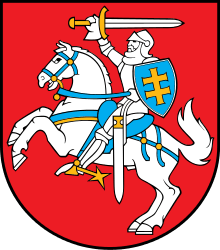Lithuanian literature
| Part of a series on the |
| Culture of Lithuania |
|---|
 |
| History |
| People |
| Languages |
|
Mythology and folklore |
| Cuisine |
| Festivals |
| Religion |
| Art |
| Literature |
|
Music and performing arts |
| Sport |
|
Monuments |
|
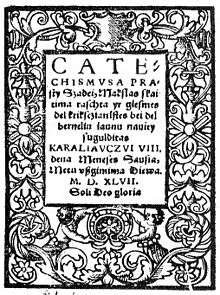
Lithuanian literature (Lithuanian: lietuvių literatūra) concerns the art of written works created by Lithuanians throughout their history.
History
Latin language

A wealth of Lithuanian literature was written in Latin,[2] the main scholarly language in the Middle Ages. The edicts of the Lithuanian King Mindaugas is the prime example of the literature of this kind. The Letters of Gediminas are another crucial heritage of the Lithuanian Latin writings.
One of the first Lithuanian authors who wrote in Latin was Nicolaus Hussovianus (around 1480 - after 1533). His poem Carmen de statura, feritate ac venatione bisontis (A Song about the Appearance, Savagery and Hunting of the Bison), published in 1523, describes the Lithuanian landscape, way of life and customs, touches on existing political problems, and reflects the clash of paganism and Christianity. A person under the pseudonym Michalo Lituanus (around 1490 - 1560) wrote a treatise De moribus tartarorum, lituanorum et moscorum (On the Customs of Tatars, Lithuanians and Muscovites) in the middle of the 16th century, but it was not published until 1615.
Petrus Roysius Maurus Alcagnicensis (around 1505 - 1571), was a lawyer and poet of Spanish birth who became an extraordinary figure in the cultural life of Lithuania in the 16th century. Augustinus Rotundus (around 1520 -1582) was a publicist, lawyer, and mayor of Vilnius, who wrote history of Lithuania in Latin around the year 1560 (no known manuscript has survived). loannes Radvanus, a humanist poet of the second half of the 16th century, wrote an epic poem imitating the Aeneid of Vergil. His Radivilias, intended as the Lithuanian national epic, was published in Vilnius in 1588.[3]
Boierus Laurentius (around 1561 - 1619) was a poet of Swedish descent, who graduated from the University of Vilnius. His main work is Carolomachia - a poem dedicated to the victory of Lithuanians over Sweden army in the Battle of Kircholm in 1605. The poem was written and published in 1606 - just after one year of the event. The poem celebrated Grand Hetman (polemarchos as referred in the poem) of Lithuania Jan Karol Chodkiewicz and the Lithuanian army. Many interesting battle details were attested in his poem, also one of the first mentionings of the Lithuanian battle cry - muški! (Latin: caede!, English: defeat!)
17th-century Lithuanian scholars also wrote in Latin, which was the common scholarly language in Catholic Europe: Kazimieras Kojelavičius-Vijūkas and Žygimantas Liauksminas are known for their Latin writings in theology, rhetorics and music. Albertas Kojalavičius-Vijūkas wrote the first printed Lithuanian history, Historia Lithuania.
Maciej Stryjkowski and Augustinus Rotundus were strong proponents of using Latin as official language of Grand Duchy of Lithuania, because they thought, that Lithuanian language is just a vernacular language which modified itself from original Latin. Their belief was based on grammatical similarities of Lithuanian and Latin.
Lithuanian language
Lithuanian scholars Abraomas Kulvietis (around 1510 - 1545), Stanislovas Rapolionis (1485 - 1545) were the very first authors to wrote in the Lithuanian language. Lithuanian literary works in the Lithuanian language were first published in the 16th century. In 1547, Martynas Mažvydas (around 1520- 1563) compiled and published the first printed Lithuanian book, The Simple Words of Catechism, which marks the beginning of printed Lithuanian literature. He was followed by Mikalojus Daukša (1527 - 1613) in Lithuania Propria with his Kathechismas, arba Mokslas kiekwienam krikszczionii priwalvs (Catechism, or Education Obligatory to Every Christian). In the 16th and 17th centuries, Lithuanian literature was primarily religious. During the 18th century, the number of secular publications increased, including dictionaries.
Konstantinas Sirvydas (1579 - 1631) religious preacher, lexicographer, published the first volume of a collection of his sermons entitled Punktai Sakymų (Sermons), the purity, style and richeness of the Lithuanian language of it is still admired today. His Polish-Latin-Lithuanian dictionary Dictionarium trium linguarum was used up to 19th century and was highly rated by the Lithuanian writers and lexicographers.
Kristijonas Donelaitis (1714 - 1780) wrote the first Lithuanian poem in hexameter Metai (The Seasons, 1818), thus laying the foundations for Lithuanian poetry. His poem is considered the most successful hexameter text in Lithuanian as yet.
Jurgis Pabrėža (1771 - 1849) - a priest, physician, botanist; wrote an encyclopedic work on botany in Samogitian dialect Taislius auguminis (Botany), created Lithuanian terminology of botany. He also wrote about 250 original sermons and a diary Ryžtai (Determinations).

Simonas Daukantas (1793 - 1864) promoted a return to Lithuania's pre-Commonwealth traditions, which he depicted as a Golden Age of Lithuania and a renewal of the native culture, based on the Lithuanian language and customs. With those ideas in mind, he wrote already in 1822 a history of Lithuania in Lithuanian - Darbai senųjų lietuvių ir žemaičių (The Deeds of Ancient Lithuanians and Samogitians), though still not yet published at that time.
Mikalojus Akelaitis (1829 - 1887) one of the most prominent creators of and publishers of Lithuanian didactic literature, publicist, ethnographer. He contributed to Auszra (The Dawn), Gazieta Lietuwiszka (The Lithuanian newspaper), composed narratives Kvestorius (1860), Jonas Išmisločius (1860). In the letter to historian Michal Balinski in 1857 he wrote: "We need to rise the Lithuanian language, to pull out of disregard the language which has the greatness of Sanskrit, power of Latin, daintiness of Greek and sonority of Italian."
Bishop Motiejus Valančius (1801 - 1875) sponsored the illegal practice of printing Lithuanian books in Lithuania Minor and smuggling them into Lithuania by knygnešiai. He wrote books himself in a rich Samogitian dialect - Palangos Juzė (Juzė from Palanga), first illustrated book for children in Lithuanian - Vaikų knygelė (The book for children), Žemaičių vyskupystė (Samogitian bishopric). He also urged to resist Russification, to protest against closing of catholic churches and monasteries. M. Valančius was one of the main figures, who laid the ground to Lithuanian National Revival.
Antanas Baranauskas (1835 - 1902) wrote a poem Anykščių šilelis (The Forest/Pinewood of Anykščiai) - the programmatic work, which had the main aim to uncover the beauty of the Lithuanian language and demonstrate it's suitability for poetry. The poem Anykščių šilelis considered the most famous syllabic verse in Lithuanian. A. Baranauskas was also a mathematician and dialectologist, created many Lithuanian mathematical terms.
The University of Vilnius promoted the usage of the language and the creation of literary works in the first half of the 19th century. But, Russia, which controlled this area through its empire, in the mid-19th century announced a 40-year ban on the printing in the Lithuanian language in the Latin alphabet. It feared an uprising from Lithuanian nationalists. As a result, publishing was transferred to East Prussia, and Lithuanian books were delivered to Lithuania by book smugglers.
20th-century literature
When the ban against printing in the Lithuanian language using the Latin alphabet was lifted in 1904, Lithuanian writers began to experiment with and adopt elements of various European literary movements such as Symbolism, impressionism, and expressionism. The first period of Lithuanian independence (1918–40), in the interwar period, gave rise to literature that explored their own society and create characters with deep emotions, as their primary concerns were no longer political.
Maironis (1862 - 1932), one of the most famous classical Lithuanian poets. He was noted for both dramatic and lyric romantic poetry and has been called “the poet-prophet of the Lithuanian national revival.” He laid the ground for the modern Lithuanian poetry. Maironis' poetry was inspired by the nature and ancient history of Lithuania - names and the deeds of the Grand Dukes of Lithuania are met often in his verses.
.jpg)
An outstanding figure of the early 20th century was Vincas Krėvė-Mickevičius (1882 - 1954), a novelist and dramatist. His many works include Dainavos šalies senų žmonių padavimai (Old Folks' Tales of Dainava, 1912) and the historical dramas Šarūnas (1911), Skirgaila (1925), and Mindaugo mirtis (The Death of Mindaugas, 1935).
Petras Vaičiūnas (1890 - 1959) was another popular playwright, producing one play each year during the 1920s and 1930s.
Vincas Mykolaitis-Putinas (1893 - 1967) [4] wrote lyric poetry, plays, and novels, including the autobiographical novel Altorių šešėly (In the Shadows of the Altars, 3 vol., 1933), in which he described a priest doubting his vocation and eventually choosing a secular life. In 1935 V.Mykolaitis renounced his priesthood and became a professor of literature.
The self-educated Žemaitė (1845–1921) published a number of short stories in the early 20th century; her frank and compassionate stories of Lithuanian village life were commemorated by her image on the 1-litas note.
Vydūnas (1868 - 1953) - philosopher, publicist and writer. He was influenced bt and joined together in his works classical European and Vedic philosophy. He was interested in Oriental philosophy as a source to revive Lithuanian national consciousness and authentic traditional culture. Main works - Mūsų uždavinys (Our Task, 1911), Tautos gyvata (The Life of the Nation, 1920), Sieben Hundert Jahre deutsch-litauischer Beziehungen (Seven Hundred Years of German-Lithuanian Relations, 1932). In 1940 was nominated for Nobel Prize.
The Keturi vėjai movement began with the publication of Prophet of the Four Winds by poet Kazys Binkis (1893–1942). This was a rebellion against traditional poetry. The theoretical basis of Keturi vėjai initially was futurism which arrived through Russia from the West; later influences were cubism, dadaism, surrealism, unanimism, and German expressionism. The most influential futurist in Lithuania was the Russian poet Vladimir Mayakovsky, who was later persecuted under Stalin's regime.[5]
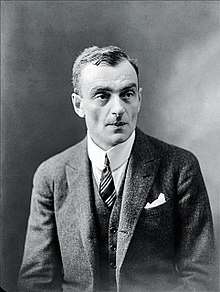
Oskaras Milašius (Oscar Vladislas de Lubicz Milosz) (1877–1939) was born and spent his childhood in Čerėja (near Mogilev, Belarus). He graduated from Lycée Janson de Sailly in Paris. In 1920, when France recognized the independence of Lithuania, he was appointed Chargé d’Affairs for Lithuania. His publications included a 1928 collection of 26 Lithuanian songs, Lithuanian Tales and Stories (1930), Lithuanian Tales (1933), and The Origin of the Lithuanian Nation (1937). His mysticism and visions were influenced by Emanuel Swedenborg. O. Milašius identified as a Lithuanian poet writing in French.
Balys Sruoga (1896-1947) wrote dramas, based on Lithuanian history or mythology - Milžino paunksmė (Under the Shade of a Giant, 1932), Radvila Perkūnas (Radvila the Thunder, 1935), Baisioji naktis (1935) and Aitvaras teisėjas (1935). During World War II, after the Nazis occupied Lithuania, in March 1943, together with forty-seven other Lithuanian intellectuals, he was sent to Stutthof concentration camp after the Nazis started a campaign against possible anti-Nazi agitation. Based on this experience, B. Sruoga later wrote his best-known work Dievų miškas (The Forest of the Gods, 1957). In the book, Sruoga revealed life in a concentration camp through the eyes of a man whose only way to save his life and maintain his dignity was to view everything through a veil of irony and sarcasm. He exposed both torturers and victims as imperfect human beings, far removed from the false ideals of their political leaders. For example, he wrote "A man is not a machine. He gets tired.", referring to the guards (kapo) beating prisoners.
Ieva Simonaitytė (1897 - 1978) represented the culture of Lithuania Minor and Klaipėda Region, territories of German East Prussia with large, but dwindling, Lithuanian population. She received critical acclaim for her novel Aukštujų Šimonių likimas (The Fate of Šimoniai from Aukštujai, 1935).
Antanas Maceina (1908 - 1987) - philosopher, existentialist, educator, and poet. His main research objects were philosophy of culture, ethics and religion. In a series of books A. Maceina discusses the existential questions of being and deals with the old theodicy puzzle concerning the genesis and justification of evil: Didysis inkvizitorius (The Grand Inquisitor, 1950), Jobo drama (The Drama of Job, 1950) and Niekšybės paslaptis (The Secret of Meanness, 1964).[6]
Vytautė Žilinskaitė (b. 1930) received two prizes for her children's books, a 1964 Journalists’ Union prize and a 1972 state prize for works classified as humorous or satiric. In 1961 she published Don’t Stop, Little Hour, a collection of poetry.[7]
Marcelijus Martinaitis (1936-2013) a poet and essayist. Main theme of his poetry - the clash of the old, archaic, rural worldview with the modern world. His main work - Kukučio baladės (The Ballads of Kukutis, 1977). The poem about a prankster, trickster Kukutis, who exposes the absurdity of the "modern new life" brought by the brutal Soviet occupation from the East was one of the catalysts for the peaceful revolution in the Lithuania. The poem was sung or recited during the mass political rallies of the late 1980s and early '90s.[8]
Sigitas Geda (1943-2008) was a productive poet and playwright. His poems connected ancient Lithuanian polytheistic religion and mythology with Greek and Sumerian myths, intertwining the old and new worlds with the ode to life and vitality. Most important works - Strazdas (1967), 26 rudens ir vasaros giesmės (26 autumn and summer songs, 1972), Žalio gintaro vėriniai (Green Amber Necklaces, 1988), libretto Strazdas - žalias paukštis (Strazdas - green bird, 1984).
Tomas Venclova (b. 1937), born in Klaipėda, is a poet, essayist, literary critic, and translator. While a professor at Vilnius University, he became involved in the Lithuanian Helsinki Group,[9] a human rights organization that included protests against Soviet activities in Lithuania. His involvement led to conflicts with the government, but in 1977 he gained permission to emigrate to the US; there he became a professor at Yale University. The Sign of Speech, a volume of poetry, published in Lithuania before his departure, was followed by other volumes of poetry, essays, and translations published in the US. Several compilations of these works were published in Lithuania after it achieved independence in the 1990s.[10] His literary criticism includes a study of Aleksander Wat.
Arvydas Šliogeris (b. 1944) is a philosopher, essayist, translator of philosophical texts, social critic. In his works A.Šliogeris researches the problems of Being and Essence, the fundamentals of Thinginess and Existence. He also the most known Lithuanian reseacher of Martin Heidegger. Esential works - Niekis ir esmas (2005), Transcendencijos tyla (1996), Daiktas ir menas (1988).
Petras Dirgėla (1947 - 2015) - prosaist, essayist, creator of historiosophic novel tradition in Lithuanian literature. Most known works - Joldijos jūra (Yoldia Sea, 1987–1988), Anciliaus ežeras (Ancylus Lake, 1991). The climax of Dirgėla's creativity - monumental four-volume (consisting of 14 books) saga Karalystė. Žemės keleivių epas (The Kingdom. An Epic of Earth Travellers, 1997–2004). His books translated into 10 languages.
Saulius Tomas Kondrotas (b. 1953) - a philosophical writer, master of short-stories. The style of S.T. Kondrotas and abstraction of the world resembles to that of Jorge Luis Borges. T.S. Kondrotas defected to West Germany in 1986. In his most famous novel Žalčio žvilgsnis (The Serpent's Gaze, 1981) he explores the problem of evil, destruction which penetrates the family and generations inconceivably. The novel was translated to 15 languages.
Jurgis Kunčinas (1947 - 2002), Ričardas Gavelis (1950 - 2002), and Jurga Ivanauskaitė (1961 - 2007) wrote novels exploring the Lithuanian condition during the late 20th century.
21st-century literature
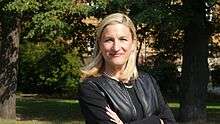
Rūta Šepetys (b. 1967) is a Lithuanian-American writer of historical fiction. As an author, she is a #1 New York Times bestseller, international bestseller, and winner of the Carnegie Medal. Her first novel, Between Shades of Gray (2011), about the Genocide of Lithuanian people after the Soviet occupation in 1941, was critically acclaimed and translated into over 30 different languages.
Kristina Sabaliauskaitė (b. 1974) debuted with her 4-volume saga of Lithuanian nobility life in the Grand Duchy of Lithuania - Silva Rerum. It became a bestseller in Lithuania and was translated into Polish and Latvian.
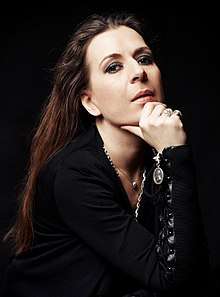
Memoirs of deportees and partisans
After regaining the Independence in 1990, many previously forbidden and unpublished literature reached the reader. Multiple volumes of memoirs Lithuanian deportees and partisans were collected and published. It is being referred to as tremties literatūra (literature of the deportations), tremtinių atsiminimai (memoirs of the deportees), partizanų literatūra (literature of the Lithuanian partisans). The most known Lithuanian partisan writers - Adolfas Ramanauskas - Vanagas (1918 - 1957), Juozas Lukša - Daumantas (1921 - 1951), Lionginas Baliukevičius - Dzūkas (1925 - 1950), Bronius Krivickas (1919 - 1952), Mamertas Indriliūnas (1920 - 1945). The book Partizanai (The Partisans) by Juozas Lukša - Daumantas was issued multiple times in Lithuania, published in the US as Fighters for freedom : Lithuanian Partisans Versus the U.S.S.R. in 1975, as Forest Brothers: The Account of an Anti-soviet Lithuanian Freedom Fighter, 1944-1948 in 2010, and in Sweden as Skogsbröder in 2005.
Lithuanian literature in exile
A body of work exists by Lithuanians who were compelled to leave the country or who emigrated as children with their parents. These authors include Antanas Škėma (1910 - 1961), Alfonsas Nyka-Nyliūnas (1919 - 2015), Marius Katiliškis (1914 - 1980), Kazys Bradūnas (1917 - 2009), Bernardas Brazdžionis (1907 - 2002), Henrikas Radauskas (1910 - 1970) and many others.[11]
Numerous Lithuanian poets were forced into exile or emigrated to flee the Soviet occupation after World War II. They wrote expressing nostalgia of the native land and Lithuanian nature, and homesteads. This movement was named Žemininkai - the land poets, using the name of the anthology Žemė (The Land) which compiled by Kazys Bradūnas and was published in Los Angeles in 1951. Five poets attributed to Žemininkai - Juozas Kėkštas (1915 -1981), Kazys Bradūnas, Alfonsas Nyka-Niliūnas, Henrikas Nagys (1920 - 1996) and Vytautas Mačernis (1921 - 1944) (posthumously).
The most famous novel by Antanas Škėma, Baltoji drobulė (White Shroud, 1958) only recently was translated into English and German and got international acclaim. [12]
References
- ↑ Radvanas, Jonas. "Radivilias, sive De vita, et rebus praeclarissime gestis immortalis memoriae". theeuropeanlibrary.org. ex officina Ioannis Kartzani. Retrieved 14 July 2018.
- ↑ Introduction to Latin language Lithuanian literature Archived 2007-10-06 at the Wayback Machine.
- ↑ Dambrauskaitė, Ramunė (1995). "A Latin Funeral Oration From Vilnius (1594)". books.google.lt. Leuven: Leuven University Press, Humanistica Lovaniensia. p. 253. Retrieved 13 July 2018.
- ↑ LMS IC: Classic Lithuanian Literature Anthology: Vincas Mykolaitis-Putinas (about the author)
- ↑ Alfonsas Nyka-Niliūnas. Keturi vėjai ir keturvėjinikai, Aidai, 1949, No. 24
- ↑ Baranova, Jūratė (2000). Lithuanian Philosophy: Persons and Ideas. The Council for Research in Values and Philosophy. p. 5. ISBN 1-56518-137-9. Retrieved 26 August 2018.
- ↑ Lietuviškos knygos Archived 2011-07-20 at the Wayback Machine.
- ↑ "The Ballads of Kukutis by Marcelijus Martinaitis Bilingual English / Lithuanian edition". Retrieved 24 August 2018.
In creating the character of Kukutis, Marcelijus Martinaitis found a voice which could articulate the anger, frustration and passions of the Lithuanian people, a voice which, contrary to all expectations, managed to escape the Soviet censor's pen and which, a decade after publication of The Ballads of Kukutis, was to become the catalyst for revolution in the Baltics. Indeed, during the mass political rallies of the late 1980s and early '90s, poems from The Ballads were chanted, sung and performed everywhere.
- ↑ International Helsinki Federation for Human Rights Archived 2006-10-02 at the Wayback Machine.
- ↑ Tomas Venclova - Jonas Zdanys
- ↑ The Experience of Exile in Lithuanian Poetry Archived 2006-08-23 at the Wayback Machine.
- ↑ "White Shroud". www.vagabondvoices.co.uk. Retrieved 25 August 2018.
Literature
- A Nyka-Niliunas. "Lithuanian Literature". Anthony Thorlby (ed). The Penguin Companion to Literature. Penguin Books. 1969. Volume 2 (European Literature). Pages 481 and 482.
- "Lithuanian literature" in Chris Murray (ed). The Hutchinson Dictionary of the Arts. Helicon Publishing Limited. 1994. Reprinted 1997. ISBN 1859860478. Page 311.
- Kvietkauskas, M. (2011). Transitions of Lithuanian Postmodernism: Lithuanian Literature in the Post-Soviet Period (On the Boundary of Two Worlds: Identity, Freedom, and Moral Imagination in the Baltics). Rodopi. ISBN 978-9042034419
- Kelertas V. (1992). Come into My Time: Lithuania in Prose Fiction, 1970-90. University of Illinois Press. ISBN 978-0252062377
- (In Lithuanian) Editors: Bradūnas K., Šilbajoris R. (1997). Lietuvių egzodo literatūra 1945-1990 / Literature of the Lithuanian exodus 1945-1990. Vilnius: Lituanistikos institutas (Chicago). ISBN 5-415-004459
External links
- Lithuanian Writers
- Lithuanian Classic Literature Anthology
- Lituanus, The Lithuanian Quarterly Journal of Arts and Sciences (English)
- A Lithuanian literature online resource
- Department of Slavic and Baltic Languages and Literatures at the University of Illinois in Chicago
- 19th century Lithuanian poetry recited by L.Noreika
- Film Strazdas - žalias paukštis based on poem of Sigitas Geda and oratorio by Bronius Kutavičius
- An Introduction to Lithuanian Literature in 8 Books
